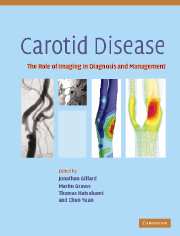Book contents
- Frontmatter
- Contents
- List of contributors
- List of abbreviations
- Introduction
- Background
- Luminal imaging techniques
- Morphological plaque imaging
- Functional plaque imaging
- 19 Nuclear imaging for the assessment of patients with carotid artery atherosclerosis
- 20 USPIO – enhanced magnetic resonance imaging of carotid atheroma
- 21 Gadolinium-enhanced plaque imaging
- 22 Carotid magnetic resonance direct thrombus imaging
- Plaque modelling
- Monitoring the local and distal effects of carotid interventions
- Monitoring pharmaceutical interventions
- Future directions in carotid plaque imaging
- Index
- References
22 - Carotid magnetic resonance direct thrombus imaging
from Functional plaque imaging
Published online by Cambridge University Press: 03 December 2009
- Frontmatter
- Contents
- List of contributors
- List of abbreviations
- Introduction
- Background
- Luminal imaging techniques
- Morphological plaque imaging
- Functional plaque imaging
- 19 Nuclear imaging for the assessment of patients with carotid artery atherosclerosis
- 20 USPIO – enhanced magnetic resonance imaging of carotid atheroma
- 21 Gadolinium-enhanced plaque imaging
- 22 Carotid magnetic resonance direct thrombus imaging
- Plaque modelling
- Monitoring the local and distal effects of carotid interventions
- Monitoring pharmaceutical interventions
- Future directions in carotid plaque imaging
- Index
- References
Summary
Atherosclerosis is the basis of the majority of carotid artery disease which, via occlusive/stenotic disease and subsequent thromboembolic events, results in end organ (brain) damage. The ability to identify atherosclerotic carotid disease, characterize those patients with disease likely to cause end organ damage and then treat this disease as noninvasively as possible underlies many research questions into carotid disease at the present time. An improved understanding of the biological processes and interactions within atherosclerotic plaque enables a more rational and targeted approach to answering some of these questions. This is the case when designing new imaging techniques that attempt to specifically identify markers of high risk.
Over the last few years there has been a rapid expansion in our knowledge of the vascular biology of vessel wall disease. The American Heart Association (AHA) has defined a progression from minimal, nonthreatening, vessel wall disease to disease that is increasingly recognized as responsible for causing the terminal events leading to asymptomatic and symptomatic thromboembolic disease with subsequent end organ damage (Stary et al., 1995). The AHA classification defines type V disease as due to fibrous thickening not thought to be responsible for thromboembolic disease. Conversion of this to type VI disease however identifies high-risk atherosclerotic plaque. The three histological markers that define this stage are: surface erosions; thrombus and intraplaque hemorrhage.
Keywords
- Type
- Chapter
- Information
- Carotid DiseaseThe Role of Imaging in Diagnosis and Management, pp. 302 - 312Publisher: Cambridge University PressPrint publication year: 2006



